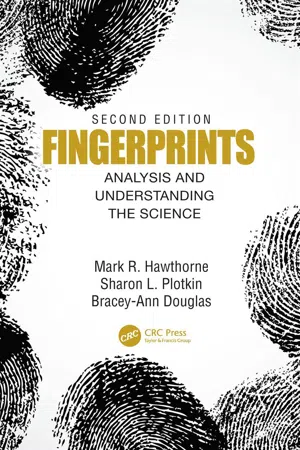
Fingerprints
Analysis and Understanding the Science
- 224 pages
- English
- ePUB (mobile friendly)
- Available on iOS & Android
Fingerprints
Analysis and Understanding the Science
About this book
Fingerprints: Analysis and Understanding the Science, Second Edition is a thorough update of Mark Hawthorne's classic written by two professionals with combined experience not only in crime scene investigations but also as court-recognized experts in latent print examination. Designed as a concise text to cover the fundamental techniques and principles of obtaining and analyzing latent fingerprint evidence, the book is laid out and written in an easy to understand format for those front-line professionals collecting and analyzing fingerprint evidence.
Over time, the degree of sophistication and education on fingerprints and friction ridge analysis has increased. Ultimately, through scientific study by pioneers in the field, the composition of friction skin soon became evident: that it could be used as a unique identifier of individuals. Now, fingerprints and footprints as unique identifiers—and their use in criminal cases—have become commonplace and an essential component of criminal investigation with most cases involving some component of fingerprint evidence.
Divided into two parts, the book begins with the basics of analysis, providing a brief history, systematic methods of identification, fingerprint pattern types and their associated terminologies and current classifications. The second part of the book discusses the identification and presentation of evidence in the courtroom, demonstrating both the traditional, manual method of lifting prints and the newer techniques for automated and live scans. Coverage provides instruction on searching and developing latent prints, storage, and comparison of prints.
New to this edition are updated techniques on collecting and preserving fingerprint evidence—including packaging and maintaining chain of custody. More detailed documentation processes, and additional chemical and lifting techniques, are described including use of light sources, latent backing cards and lifting material, casting material, ten print cards, and the enhancement of prints in blood. A discussion of laboratory equipment and comparison tools, the addition of photography techniques, and recent courtroom challenges to fingerprint evidence is also presented.
Fingerprints, Second Edition will provide a hands-on, fresh look at the most commonly utilized evidence found at crime scenes: fingerprints. The book will provide law enforcement, crime scene personnel and students just such an opportunity to easily understand and grasp the concepts, and relevant issues, associated with friction skin and fingerprint evidence.
Frequently asked questions
- Essential is ideal for learners and professionals who enjoy exploring a wide range of subjects. Access the Essential Library with 800,000+ trusted titles and best-sellers across business, personal growth, and the humanities. Includes unlimited reading time and Standard Read Aloud voice.
- Complete: Perfect for advanced learners and researchers needing full, unrestricted access. Unlock 1.4M+ books across hundreds of subjects, including academic and specialized titles. The Complete Plan also includes advanced features like Premium Read Aloud and Research Assistant.
Please note we cannot support devices running on iOS 13 and Android 7 or earlier. Learn more about using the app.
Information
Part I
The History of Fingerprints | 1 |
Outline of the History of Fingerprints
Table of contents
- Cover
- Half Title
- Title Page
- Copyright Page
- Contents
- Preface
- Acknowledgements
- About the Authors
- Part I: Fingerprint Analysis
- Part II: Development, Identification, and Presentation of Fingerprints